Here it is, late June in Alabama, and the forecast is for thunderstorms practically every afternoon, temperatures consistently in the 90s, and high humidity 24 hours a day. It is under these conditions that I find myself meeting my good friends A. & E. for lunch at a brand new Birmingham eatery named, ironically, Melt.
Melt started life as a food truck specializing in the simple grilled cheese sandwich and its countless variations. It was a roving hit, which is unsurprising in this Age of the Food Truck. Apparently, business was so good that the two women who own the mobile business decided to plant their operation on the ground somewhere. They found a perfect spot: a vacated gas station on a corner in the rapidly-rejuvenating Avondale district, just a one-block stroll from the lushness of the recently refurbished Avondale Park.
I’ll interrupt myself briefly here to say that the concept and name of Melt isn’t entirely original. Last month, I was mapping out stops for a road trip that, sadly, didn’t occur. I discovered the presence of a cheese-based restaurant named Melt in Cincinnati, and it was penciled in as a food stop for that day. But Cincinnati isn’t Birmingham, and this nearby joint has a local flavor that tastes very specifically of Avondale.
Melt Birmingham makes creative use of the building, dividing the restaurant into three distinct areas: what I’d call the main room, which contains the clearly-visible kitchen area and a dine-at bar; a side dining area that has two roll-up garage doors as one of its walls; and an additional glassed-in space constructed where the gas pumps must have previously been located. Re-purposed materials abound. One wall in the main room is completely covered, floor to ceiling, by a battered tin sign that reads VOTE NO TO TAX INCREASE. The doors to the restrooms, as well as the entire wall surrounding them, are covered with horizontal planks of weathered wood. And the old signs advertising gasoline prices hold a prominent spot on the wall of the side room.
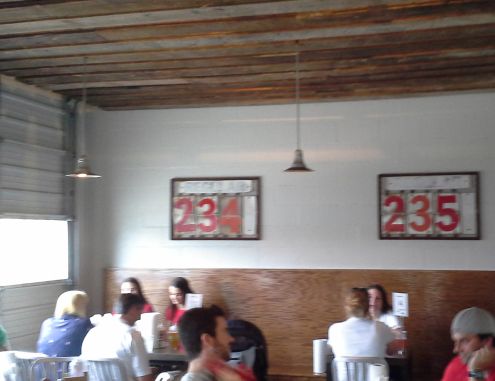
You can also see, in the photograph above (and despite its blurriness), recycled wood used on the ceiling.
The restaurant opened on Tuesday, June 24th. Two days later, Bob Carlton, food writer for al.com, posted a column detailing the history of Melt and, in essence, giving the two-day-old place a rave. Speaking to A. & E. on the phone on Friday, we discussed going to see a film and catching some lunch beforehand. I had just read Bob’s article, so we decided to go there and get on the front end of the wave.
When I arrived there early, at 11:40 AM, there was already a line to the door waiting to order (Melt does not offer traditional table-side ordering, but does deliver your meals to you). The joint was buzzing. Social media and good word-of-mouth do indeed have power.
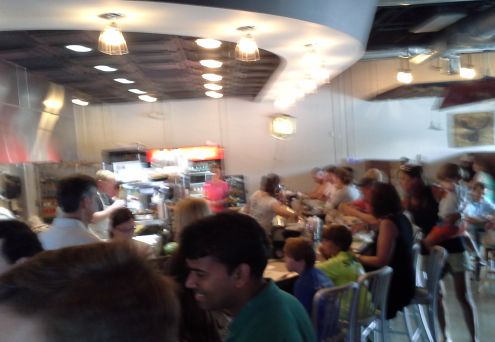
A. got the basic three-cheese sandwich with fries, and E. got a turkey grilled cheese with house-made potato chips. I got the Mushroom & Truffle, a grilled sourdough bread sandwich containing porcini mushrooms, Roma tomatoes, truffle oil and – what else? – cheese. I requested an addition of bacon. That was the perfecting touch, and I recommend it. The menu encourages patrons to add ingredients to their orders (at an additional charge, of course…these restauranteurs are no dummies!), which is a small touch that only adds to the creative ambiance of the place.
After the meal, we headed over to the local Edge 12 movie theater and saw Chef. Not only was this a fitting complement to our interesting dining experience, but there was an extra twist: we had just left a restaurant that had begun life in a food truck, to view a movie about a fine-dining restaurant chef who finds personal redemption working on a food truck.

Tags: film · food · My South: A to Z
I had several days off from work recently. Even though I had planned a road trip centered around stops at Frank Lloyd Wright’s Falling Water house in Pennsylvania and the Rock & Roll Hall of Fame in Cleveland, I stayed home. It is much less expensive to have a staycation, and the “stay” part of the word had, in fact, forced my decision – five or six days of hotel/motel rates are far beyond my allowable budget.
Yes, there was yardwork. Yes, there were home chores. Yes, there was sleeping-in. Yes, there was dietary and physical self-improvement. And, yes, I spent a little time discovering parts of my city.
One thing I did was visit the Birmingham Civil Rights Institute, which is located directly across the street from the 16th Street Baptist Church. The Church was the site of the 1963 bombing that killed four young girls. It is an iconic landmark, and the Institute – opened in 1992 – has become a must-see destination for visitors to the city. I had never been before.
So, 22 years after its opening, this Birmingham resident since 1987 finally gets there. It’s an immersive experience, the stiff but verbose ticket-taker told me. She also said that I would be takng the self-guided tour – do-it-yourself, if you will. However, there was a large group of mostly-elderly black visitors being led into the museum directly ahead of me, so I joined their tour. It turned out that they were former members of the Birmingham Black Barons baseball teams of decades ago, in town for the next day’s annual Rickwood Classic. I felt honored just to be in their presence.
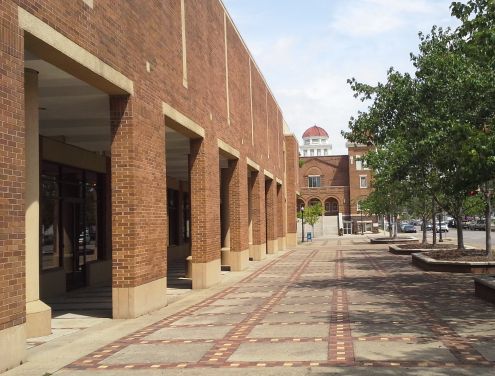
Across the street from the Institute, kitty-cornered from the 16th Street Church, is Kelly Ingram Park (formerly West Park), a full city-block park that holds an interesting place in civil rights history. It was on this square of land that people would gather prior to heading out on protests during the ’60s. It has been updated as a stop on Birmingham’s “Freedom Walk.” A circular path around the park is dotted with statues and sculptures detailing highlights and aspects of the local battle for basic rights.
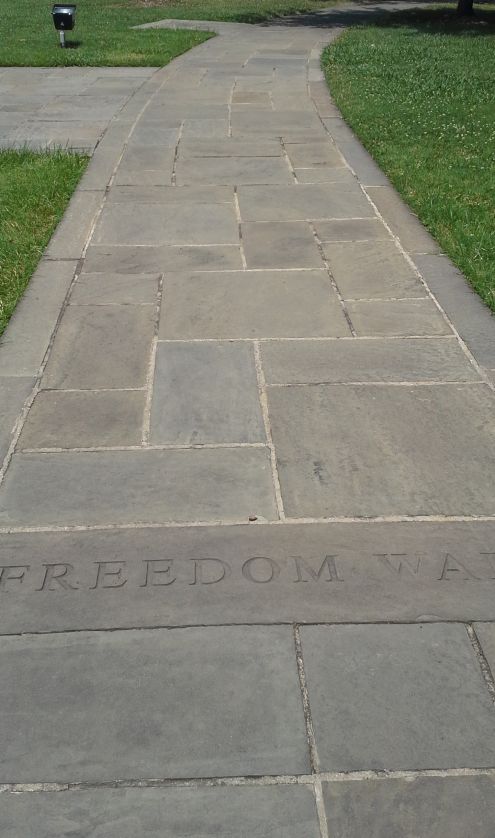
The Children’s Crusade monument has greater impact when viewed through the iron bars of the prison window, placed across the Freedom Walk. On May 2nd, 1963, 959 children, ages 6 to 18, were arrested under the direction of Birmingham Public Safety Commissioner “Bull” Connor.
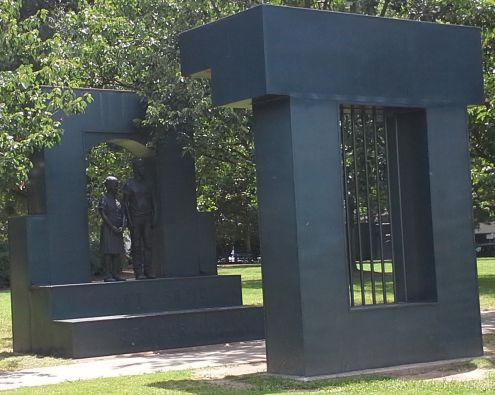
The inscription at the base of James Drake’s monument reads: I AIN’T AFRAID OF YOUR JAIL.
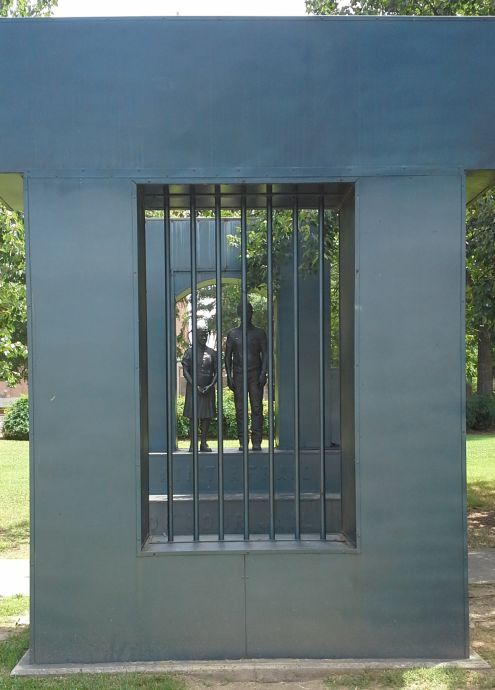
“Police Dog Attack” by James Drake:
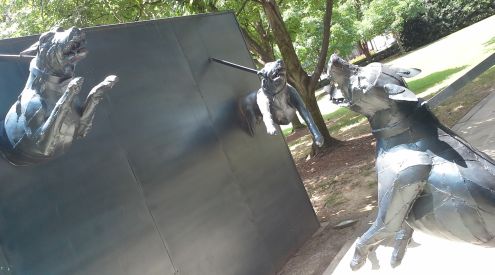
Dogs were used to frighten and attack protesters during this struggle. The Freedom Walk passes between two walls from which sculptures of vicious dogs leap out. It is quite unnerving. It is meant to be.

Again (below) with the dogs.
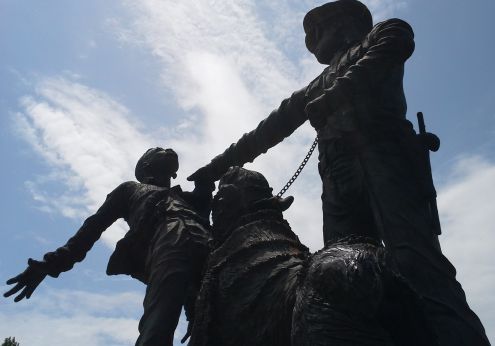
This statue is titled The Salute to the Foot Soldiers, and was created by Dr. Ronald Scott McDowell. The plaque at its base reads:
This sculpture is dedicated to the foot soldiers of the Birmingham Civil Rights Movement.
With gallantry, courage and great bravery they faced the violence of attack dogs, high powered water hoses and bombings. They were the fodder in the advance against injustice, warriors of a just cause; they represent humanity unshaken in their firm belief in their nation’s commitment to liberty and justice for all.
We salute these men and women who were the soldiers of this great cause.
Richard Arrington, Jr.
Mayor of Birmingham
May 1995

Tags: My South: A to Z
An asymptomatic condition of some concern to my primary physician found me sitting in a specialist’s examining room on a recent morning. Pushed up alongside one wall was the examination table: a well-worn piece of equipment with cracking leather corners, faded paint on its legs forcing a resemblance to an abandoned pommel horse base circa 1977 – a crackling, long sheet of tissue paper strategically placed in an apparent effort to conceal those details. The table occupied the length of the wall, and led my eyes, upon entering the room, to the plate glass window that occupied its perpendicular neighbor. The window was adorned with aluminum blinds, half-opened to afford a panoramic view of the hospital campus from the room’s fifth-floor perch. After spending a few minutes taking in the sights, watching the green lights at the intersection turn to red a number of times while three shuttles performed their drop-off-pick-up duties at the adjacent building’s entrance, I turned around to face the door – now closed – through which I had entered. I sat down in a stiff chair with my back to the window.
Centered on the wall opposite the examining table, to the right of a small sink and above a rolling stool that, I assumed, the specialist would soon be occupying, was a large framed photograph.
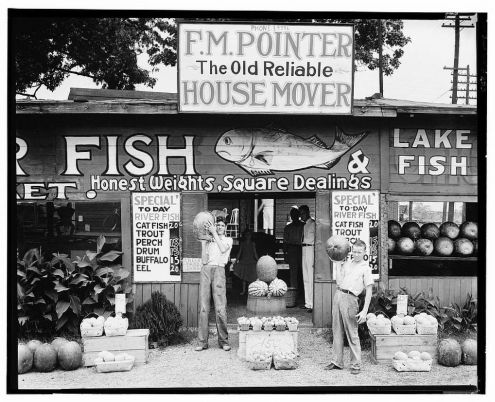
Peeking out from the bottom of the print, almost obscured by the frame, was the photo credit: Walker Evans Roadside stand near Birmingham, Alabama 1936. I leaned back on my heels, in front of the picture, and soaked in the details: the hand-painted signs, the telegraph poles, the onlookers in the background, the weight of the melons in the boys’ hands, the price of eel, the fish face frown, the outdated phone number configuration, the oddly-placed apostrophes, the stacked fruit orbs in the window.
Presently, the physician entered and sat squarely where I thought he might. He rolled to the center of the small room and faced me. The Walker Evans photograph was between us, off to the side of our avenue of communication. We discussed his concerns. I mentioned my asymptomatic state. He proposed a plan of discovery to rule out his concerns. I gave my consent to go forward. During the discussion, I occasionally glanced to my left, toward the Walker Evans photograph. When we finished this stage of my visit, I gently detoured with an observation.
“That’s a fascinating photograph.”
He turned toward it and lit up. “A Walker Evans, yes. That’s an exhibition print. It’s a rather famous photograph.” He seemed to hold this particular picture in high esteem and had obviously spent some quality time admiring it. “You know, for that exhibition – in the 1980s, I think – they went to all of the sites of the original Evans photographs and recaptured them in the present day. That fish stand is just right outside of town,” meaning Birmingham, the largest “town” in the state of Alabama, where we were meeting. “The updated version of this photo has two boys holding fish, not melons. And that building is gone now.”
I asked if he had been the one who had selected this print to adorn the walls of the exam room.
“No, this is my partner’s print,” he said, referring to the other physician whose name was on the office door. He then paused, anticipating an explanation of my initial observation.
I turned my eyes to the print. “I was wondering if you thought that there was something maybe a little odd about the picture.”
He turned and made a cursory scan of the picture he’d glanced at hundreds of times before. “I don’t know what you mean.”
“Well, I don’t know if it was intentional or not, but, mm, it’s oddly fitting that in the center of that photograph is a pretty obvious representation of, you know, for this being a urology practice.”
Puzzled, he took another look. It took him no more than a couple of seconds to see the central image – the watermelon phallus – and he laughed. “I’d never noticed that,” he said, to my disbelief and his quiet amusement. Then he swiveled back toward me. “So. Now. Stand up, facing me, and let your pants drop to your ankles.”
[This piece was originally posted circa 2011 or 2012 at V’s Place, a website now sadly – but, hopefully, only temporarily – retired.]
Tags: My Eye · My South: A to Z · photography
Rickwood Field was built in the west side of Birmingham in 1910 – in the area near what is now referred to as Ensley – to house the Birmingham Black Barons of the Negro League. Its 104 years of age apparently makes it the oldest surviving pro baseball park in America. How lucky are we to have this facility right here in our corner of the world? Answer: very.
Here’s a vintage photo of a game on Rickwood Field from back in 1929 (click on the image to get a full-blown picture):
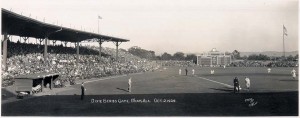
(photo: rickwoodclassic.com)
The annual Rickwood Classic takes place in the middle of the summer baseball season, in the middle of the week, in the middle of the day. Today, in fact.
I have been to the Rickwood Classic twice. Both times, it was a humid, sticky, early Summer day. I sweated a lot, as did everyone around me. Hence, no one noticed. The members of the crowd that couldn’t stand the direct sun were bunched up under the little bit of shade beneath the park’s awnings, fanning themselves. I can only imagine what the regular ballgame attendees of the ’20s and ’30s felt like within their woolen suits and multiple layers of clothing.
The players on the current-day Birmingham Barons team and the Minor League team that plays against them in this one-day event wear uniforms modeled after the designs of a given year. This year, the event commemorates the “Roaring Twenties.” The place turns into a time capsule of pin-striped baseball uniforms and a sea of spectators dotted with wide-brimmed straw hats and floppy headdresses. The small concessions stand even serves up helpings of slow-roasted Boston Butt. Mint julep, anyone?
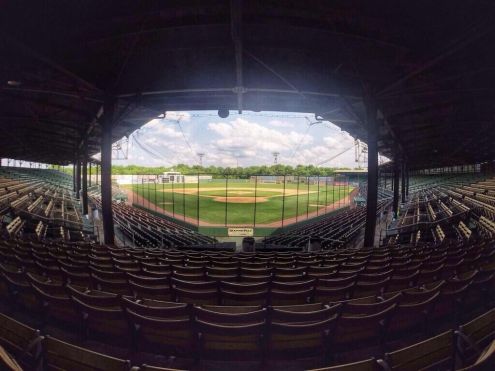
On one of my prior trips to the Rickwood Classic, I won an auction bid on a 1960s-era Barons uniform. It’s hanging in my closet now, though I did wear it in 2007 as a Halloween costume to a Josh Ritter concert.
Tags: My South: A to Z
Irondale is the small city immediately east of the city of Birmingham’s Crestwood neighborhood, which is where I live. To call Irondale a city seems perhaps faulty, as it has as its center a sleepy little train-stop of a village. But, due to its acreage and the fact that it is indeed incorporated, it is a city. But it’s not a City.
I see Irondale from the Interstate every day as I drive to and from work in Leeds, the city (again, this “city” thing is questionable) immediately east of it. On days when I don’t feel pressed for time, I usually turn off of the highway and cut through the few blocks of 1940s-era buildings. My goal is often the public library there, but sometimes it’s calming to just roll down the windows and look at houses. There are other things to see there, too. It’s just nice there. Feels like a step back in time, to be honest, and that comforts me.
Just as they do in Birmingham, train tracks seem to bisect Irondale Center in two. The tracks take a wide slow lazy bend through town

and disappear through the trees, leaving the clearing of green behind.

There is a small building next to the rails called Studio by the Tracks. It is charming, and I can imagine that it was a home at one time. It’s nestled up against the gravel embankment that supports the train tracks. That structure must rattle and shake whenever a train goes by. The photograph above, in fact, was taken from the parking area in front of the Studio. Yep, it’s that close.
The Studio by the Tracks describes itself (on its website) as:
…a non-profit organization formed in 1989 to provide free art classes to emotionally conflicted children and adults with Autism Spectrum Disorder or other mental illnesses. SBTT maintains a focused, energized atmosphere that provides our students a haven in which to create. We encourage a supportive and non-judgmental climate necessary to nurture creative abilities, enhance self-esteem and explore alternative ways of coping with emotional and physical conflict.
They have fundraisers annually that showcase the artwork created therein. Many of the pieces are astonishing. I have a friend whose office space (and probably his home) are packed with purchases he’s made at these events. You can see a generous sampling of recent work at the SBTT website, including this little marvel

and this portrait, which is truly heartwarming.

On a recent day, I parked my car and strolled through the Studio’s courtyard. There I found two examples of Christmas trees, only a little bit out of season,
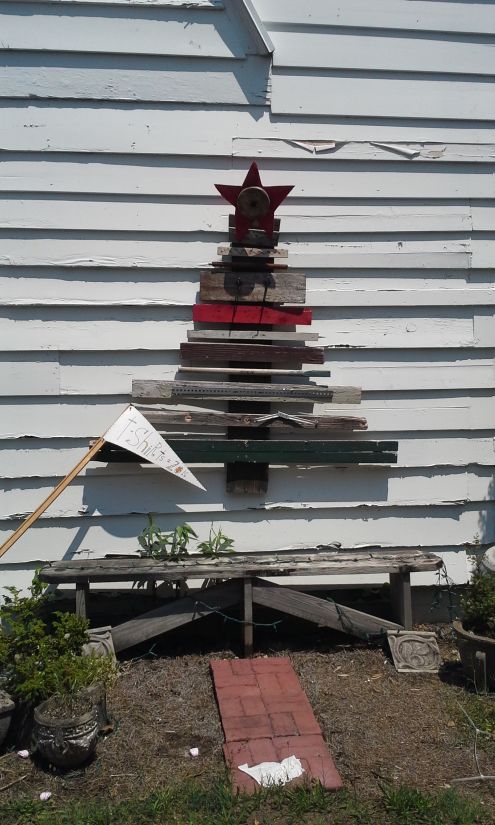

as I walked over bricks and bits of broken crockery.
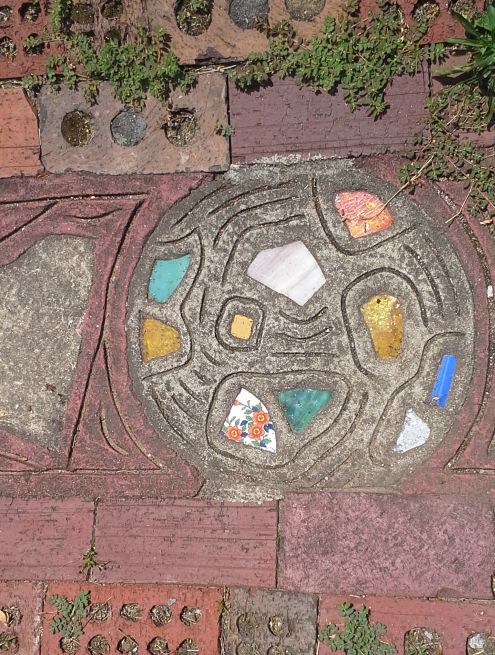
Diagonally across the street and the tracks from the Studio is a brick building with the remnants of a painted advertisement still visible on its side, peeking out from behind some crape myrtle trees. I could only decipher the top portion of the ad, which read: J. T. Ramsey & Son General Merchandise.
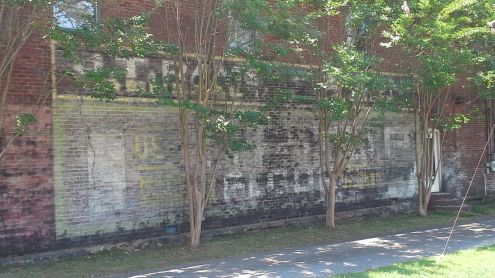
The larger section beneath that uses the word FLOOR, but the context escapes me. There are several such faded wall ads around this town. I feel I should make an effort to photograph them all.
Up the road from the Studio by the Tracks is the aforementioned library. It’s in a bland 1970s block-and-glass building with no color and plentiful right angles. And just one block past that are the main train tracks that carry most of the commercial traffic that passes through Irondale. It is here, at this junction, that the Whistle Stop Cafe sits. If you have read supposed native daughter Fannie Flagg’s novel Fried Green Tomatoes at the Whistle Stop Cafe or seen the movie made from it, you are aware of this place. Yes, this is the place, a cafeteria-style home-cookin’ joint that serves those fried tomatoes and has some really awesome fried chicken. And they have some other fried things on the menu, too, this being the South. And their dining room walls are adorned with dozens of paintings created by the artists at the Studio by the Tracks.
This is my Irondale.
If you lived here, it might be boring as hell, but it’s a charming place to drive through and set a spell.
Tags: My South: A to Z
Not long after I purchased my cozy little bungalow many years ago, I “hired” the younger sister of one of my employees to try her hand at landscaping the back yard. She was studying landscape design and needed experience. I was her guinea pig, as people used to say. Her subject. And my bare yard and its border were her canvases [if you’ll allow me the mixed metaphor].
She did a fine job. Most of what she planted has gone now, but the hardscapes she placed there (a circular brick planter in the center of the patio, and a rustic stone border outlining the flower beds) remain. Her red canna lilies now poke their heads up through a compost heap; the lilac bush has grown gangly and threatening; the only evidence of her plantings in the patio planter are a cluster of fire-red tipped somethings that seem a cross between lilies and Birds of Paradise.

But I miss the purple coneflowers. They are possibly my favorite flower.

This seems to be the most common form of Echinacea flower around these parts. Many of my neighbors have them growing in small or sometimes large clusters in their yards. They have a delicate beauty, but demonstrate a hardiness not often found in a flower: you can thump the rock-hard cone in the center of the bloom and actually hear an audible “thump.”
The Black-Eyed Susans (or Rudbeckias) growing in my next-door neighbors’ yard appear to be a coneflower variant. I thumped them in the cone, just to be sure.

I started the job myself, but am hopefully going to have some help this week clearing out most of what remains in those beds. The crape myrtle bushes that I planted years ago will remain, but the plan is to till everything else up for a fresh start.
And – guaranteed – the new garden will definitely include some thumpable Echinacea.
Tags: My South: A to Z
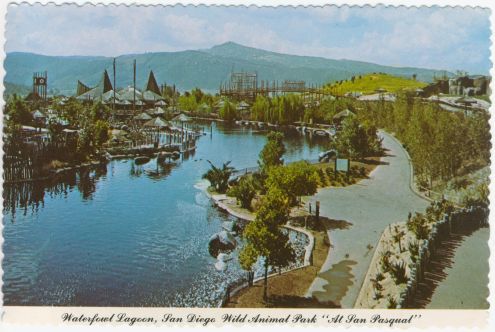
Card is titled: Waterfowl Lagoon, San Diego Wild Animal Park “At San Pasqual.”
Printed on back of postcard:
SAN DIEGO WILD ANIMAL PARK “AT SAN PASQUAL”
Waterfowl Lagoon
ZW-38
SAN DIEGO ZOO PHOTO.
Publishing information:
Curteichcolor® 3-D Natural Color Reproduction (Reg. U.S.A. Pat. Off.)
Tags: postcards
This remake was unnecessary. They could have at least copied the original’s shock ending.
Tags: film · Screenings · Twitter
My very demanding computer ordered me to update its iTunes program recently, so I did it, rather than face the unknown consequences of not having an updated iTunes program. The last thing I want is to not be able to access the tens of thousands of mp3 files on the hard drive.
Yes, there are that many.
Having so many music files has led me, over the years, to enjoy the element of surprise that comes with setting the Play function to Random. What comes up next could be a Beatles song, a Horace Silver hard bop anthem, a movement from an early Dvorák symphony, or a Bob Newhart sketch about defusing a bomb. As a result of this attention-grabbing play mode, I rarely listen straight through to albums, like we used to do back when our only music-delivery system was a black vinyl platter. Times change, truly.
I noticed that there was a new (or maybe not new, but just newly-noticed by me) feature on iTunes called “Genius.” (Such hubris!) I thought I’d try it, so I plugged in a song from one of my favorite albums and instantly had a two-hour playlist based on Josh Rouse’s “Streetlights” (from his Nashville). I shaved off the tail end of the playlist so that the collection would fit onto an 80-minute CD, burned the thing, and popped it into the truck’s CD player.
I’d been cycling through the playlist for a couple of days, enjoying the mix that really did complement the Josh Rouse song well. There were some early ’00’s rock songs from the likes of Pete Yorn and Matt Pond PA, but the majority of the selections were straight-ahead Americana: Jayhawks, Wilco, Josh Ritter, Whiskeytown and Ryan Adams. It was – and is – quite nice; eerily so, as if I had consciously compiled the tracks myself.
I kept replaying one song, in particular. Penned by Whiskeytown frontman Ryan Adams and recorded by that group on their second album, Strangers Almanac, it’s about as simply-structured as a song can be. Yet, like a movement from a Beethoven symphony, perhaps, its beginning verse relates to its central verse which leads very naturally to the conclusions of the final verse, and the practically-identical choruses bridge them all, creating a light-bulb revelation to the listener once the tune’s conclusion is reached.
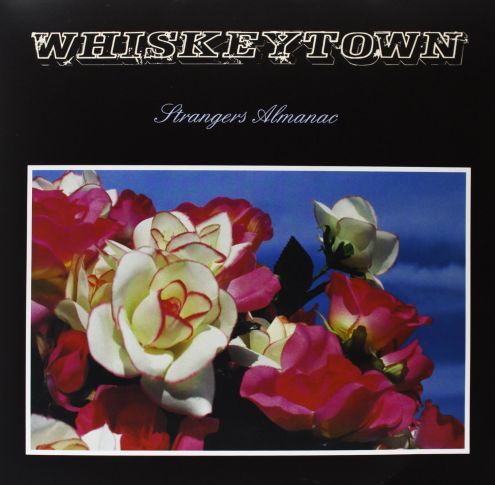
You may get something different from the song, but, to me, Dancing with the Women at the Bar describes a tragedy of inheritance. The father’s philandering behavior leads to the son’s carousing which, it is hinted in the lyrics, is an influence on his cronies and, one would reasonably guess, on his own son, too. In my current frame of thinking, and in my current geographic placement, this seems like a particularly Southern myth of legacy. I am familiar with more Sr’s, Jr’s and III’s around here than in any other place I have yet lived (the many legacy sons I knew in Cambridge came there from all over the world), and assume that those men share more familial traits – both respectable and unsavory – than just their name. Brick and Big Daddy (in Cat on a Hot Tin Roof) and their Mississippi-based cycle of lies and alcoholism and dysfunctional sexual relationships come immediately to mind. Surely, you can rattle one or two cultural examples off the top of your head, too. Maybe you’ve even known a guy like the fellow in this song: night falls and he’s pulled by a mighty impulse to a nearby bar, where he drinks and flirts in the hope of replacing something he’s missing or has lost, knowing full well that he’s repeating a pattern, but unable to quell the crushing leverage of his history.
The foot-tapping, ambling country rhythm of the song – which seems to want to communicate the lyrics as wistful – just makes the tragedy of this situation feel more devastating and poignant.
[audio:Whiskeytown_Dancing with the Women at the Bar.mp3]
When I see the moon, I hear the sound of the strip
Just calling my name
Just calling my name
When I see the moon, I hear the sound of the strip
Just calling my name
Yeah, its calling my name
Man, I love the feeling
When I go out
Dancing with the women at the bar
Man, I love the feeling
When I go out
I always know my woman’s close somewhere
My daddy saw the moon, heard the sound of the strip
It called out his name
It called out his name
My daddy saw the moon and heard the sound of the strip
Yeah, it called out his name
And it called his son’s name, too
Man, I love the feeling
When I go out
Dancing with the women at the bar
Man, I love the feeling
When I go out
I always know my woman’s close somewhere
Close somewhere
When you see the moon, hear the sound of the strip
Yeah, call out my name
Yeah, call out my name
And if you see the moon or hear the sound of the strip
Yeah, call out my name
Yeah, and call my friends’ names, too
Man, I love the feeling
When I go out
Dancing with the women at the bar
Man, I love the feeling
When I go out
I always know my woman’s close somewhere
Close somewhere
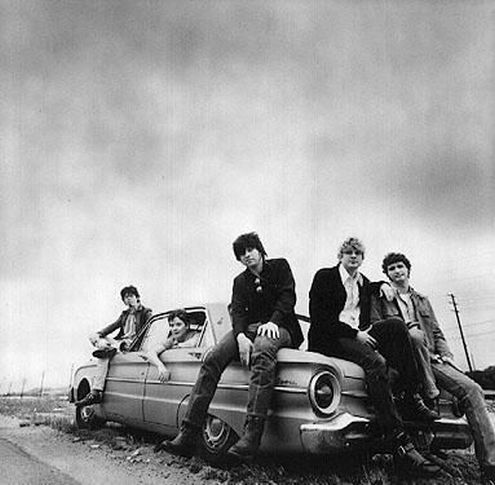
Tags: My South: A to Z · Random Song Machine
The tolerance lesson is obvious from the start, but this French animation charms throughout. Vivid character quirks for a bunch of anthropomorphs.
Tags: film · Screenings · Twitter





























